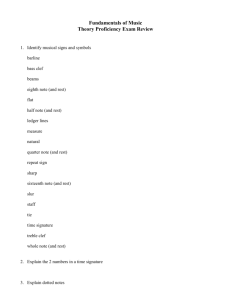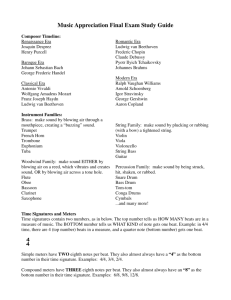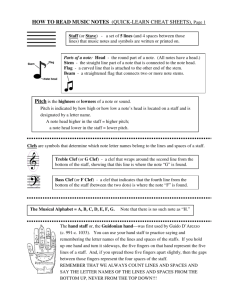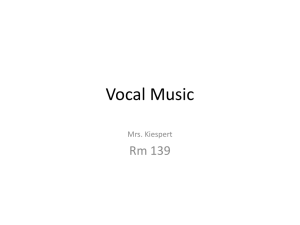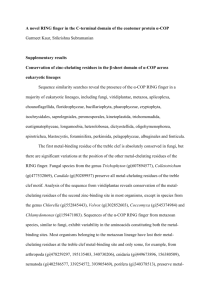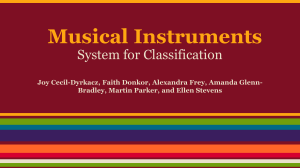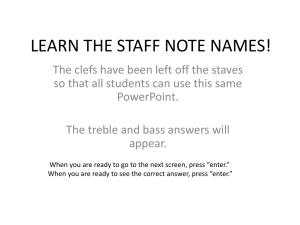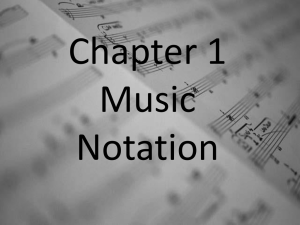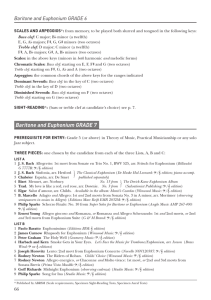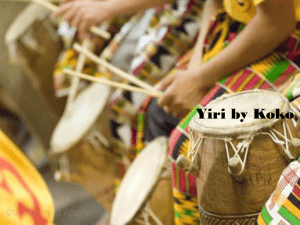Music Theory 101
advertisement
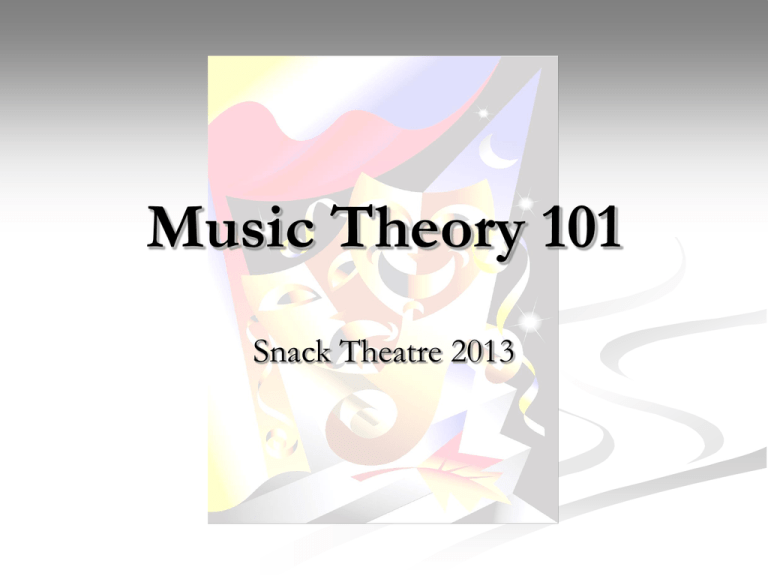
Music Theory 101 Snack Theatre 2013 The Beginning A staff is made up of five horizontal lines and four spaces A clef is a musical symbol placed at the beginning of the staff that determines the letter names of the lines and spaces. The two main clefs are the treble and the bass: Treble Clef Treble Clef (TOP) Bass Clef (BOTTOM) Bass Clef The Beginning The music we do in Snack Theatre is often SATB (4 parts: Soprano, Alto, Tenor, Bass), SAB (3 part: Soprano, Alto, Men) or Two-Part (Soprano/Tenor, Alto/Bass) TYPICALLY, women’s music parts are written on the treble clef and men’s music parts are written on the bass clef Soprano typically refers to female singers and is a voice type with a vocal range from approximately middle C to "high A" in choral music. In four-part chorale style harmony, the soprano takes the highest part, which usually encompasses the melody. The music part is often the top line of the treble clef. Alto refers to the second highest part of a choral music and is approximately from the G below middle C to the F in the second octave above middle C. The music part is often the bottom line of the treble clef. The tenor is a type of singing voice and is the highest male voice within the modal register. The tenor voice lies between the C one octave below middle C, and the A above middle C. The music part is often the top line of the bass clef. Baritone is a type of male singing voice that lies between the bass and tenor voices. It is the most common male voice. Music for this voice is typically written in the range from the second F below middle C to the F above middle C in choral music, but can be extended at either end. A bass is a type of male singing voice and possesses the lowest vocal range of all voice types. A bass is typically classified as having a range extending from around the second E below middle C to the E above middle C. The music part is often the bottom line of the bass clef. Occasionally, the treble clef will split into 3 parts – the sopranos split and the Second Sopranos or Mezzo-Sopranos will sing that part The Beginning A single vertical line drawn to the left of multiple staffs creates a grand staff and a system, indicating that the music on all the staffs is to be played/sung at the same time. A measure or bar line refers to the vertical lines drawn through the staff to mark off metrical units. A double bar-line can consist of two single bar-lines drawn close together, separating two sections within a piece, OR a bar-line followed by a thicker bar-line, indicating the end of a piece. A repeat sign looks like the music end, but it has two dots, one above the other, indicating that the section of music that is before is to be repeated. The beginning of the repeated passage can be marked by a begin-repeat sign; if this is absent the repeat is understood to be from the beginning of the piece or movement. Pitches Pitches are named after the first seven letters of the alphabet (A B C D E F G) and follow that same order for both treble and bass clef Some standard acronyms to help remember the notes on a staff are: The smallest interval used in Western music is the half step. A visual representation of a half step would be the distance between a consecutive white and black note on the piano. There are two exceptions to this rule, as two natural half steps occur between the notes E and F, and B and C. A whole step is made up of two half steps. Letter names are modified by the accidentals. A sharp raises a note by a half-step, and a flat lowers it by the same amount. A natural is an accidental which cancels previous accidentals and represents the unaltered pitch of a note A flat, C sharp, A natural Pitches – Application C natural G# Bb D# E# Ab Pitches – Answers C natural G# Bb D# E# Ab Notes Each type of note has a specific look and a specific duration: A note value may be augmented by adding a dot after it. This dot adds the next lower note value, making it one and a half times its original duration. 1 beat + ½ beat = 1.5 beats 2 beats + 2/2 beats = 3 beats Time Signatures Time signatures indicate the meter the song is in which indicate how many beats are in each measure and which note value constitutes one beat. In a musical score, the time signature appears at the beginning of the piece, usually as stacked numerals immediately following the key signature (or immediately following the clef if the key signature is empty). A mid-score time signature, usually immediately following a barline, indicates a change of meter. There are various types of time signatures, depending on whether the music follows simple rhythms or involves unusual shifting tempos, including: simple and compound Time Signatures Simple time signatures consist of two numerals, one stacked above the other: the lower numeral indicates the note value which represents one beat (4 = quarter, 8 = eighth, 1 = whole, etc) the upper numeral indicates how many such beats there are in a bar For instance, 2 / 4 means two quarter-note beats per measure 6 / 8 means six eighth-note beats per measure, but is felt in “2” A is sometimes used to refer to 4 / 4 time Compound time signatures split the “feel” into 3 instead of 2. The most common time signatures that we will deal with are (1,2,3) + (1,2,3) Key Signatures A key signature is a series of sharp or flat symbols placed on the staff, that are to be consistently played one semitone higher or lower than the equivalent natural notes unless otherwise altered with an accidental. Key signatures are generally written immediately after the clef at the beginning of a line of musical notation, although they can appear in other parts of a score, notably after a double barline. A key signature will have either sharps or flats, but there will not be any key signatures with both. To determine the key based on the key signature: 1. If the key signature has sharps, look at the position of the last sharp and raise it by a half-step to get the key. For example, if the last sharp is C, raise it a half step which is D, the key is D major. When the key signature has flats, simply look at the second to the last flat and you get the key. So for example A flat is the second to the last flat sign in the key signature, this means the music is in A flat major. The exception to this rule is F major because it only has one flat and C major because it has no flats or sharps. 2. 3. 4. 5. 6. 7. 8. Intervals Intervals are the distance between two notes Major intervals M2 – Happy Birthday, Silent Night M3 – I Could Have Danced All Night, When the Saints Go Marching In P4 – Here Comes The Bride, Taps M5 – Star Wars Theme, Twinkle Twinkle, Can’t Help Loving Dat Man M6 – NBC Theme, My Bonnie Lies Over the Ocean M7 – Bali Hai M8 (octave) – Somewhere Over the Rainbow Minor intervals m2 – Jaws M3 – O Canada, So Long, Farewell Dynamics Dynamics refers to the volume of a note/piece/sound The two basic dynamic indications in music are: More subtle degrees of loudness or softness are indicated by: p or piano, meaning "soft" f or forte, meaning "loud" mp, standing for mezzo-piano, meaning "moderately soft" mf, standing for mezzo-forte, meaning "moderately loud“ pp “pianissimo” meaning “very soft” ff “fortissimo” meaning “very loud” Two Italian words are used to show gradual changes in volume. Crescendo, abbreviated cresc., translates as "gradually becoming louder", and diminuendo, abbreviated dim., means "gradually becoming softer". The alternate decrescendo, abbreviated to decresc., also means "gradually becoming softer“. Tempo Tempo (Italian for time) is the speed/pace of a given piece. The tempo of a piece will typically be written at the start of a piece of music, and is usually indicated in beats per minute (BPM). This means that a particular note value (for example, a quarter note or crotchet) is specified as the beat, and the marking indicates that a certain number of these beats must be played per minute. The greater the tempo, the larger the number of beats that must be played in a minute is, and, therefore, the faster a piece must be played. Basic Tempo Markings: Largo – broadly (40–50 BPM) Adagio – slow/stately (literally, "at ease") (51–60 BPM) Adagietto – rather slow (61–80 BPM) Andante – at a walking pace (61–80 BPM) Moderato – moderately (81–90 BPM) Allegro – fast, quickly and bright (105–132 BPM) Presto – very fast (168–177 BPM) Changes In Tempo & Articulation Accelerando – speeding up (abbreviation: accel.) Rallentando – gradual slowing down (abbreviation: rall.) or broadening of tempo Ritardando – slowing down gradually; (abbreviations: rit., ritard.) Rubato – free adjustment of tempo for expressive purposes a tempo – in time; return to the main tempo of the piece (often after an accelerando or ritardando, etc.) Staccato (Italian for detached) signifies a note of shortened duration, separated from the note that may follow by silence. Legato (Italian for "tied together") indicates that musical notes are played or sung smoothly and connected Slur - a curved line used to indicate that notes should be interpretted as a phrase and often in one breath. Codas Coda (Italian for "tail") designates a passage that brings a piece/movement to an end. It may be as simple as a few measures, or as complex as an entire section. Da Capo meaning from the beginning. It is often abbreviated D.C. Dal Segno meaning from the sign. It is often abbreviated D.S Segno Coda Codas Da Capo al Fine (D.C. al Fine): repeat from beginning to the end (or up to the word fine, should that appear at the end of the passage – the word fine itself signifying “end”). Dal Segno al Fine (D.S. al Fine): repeat from beginning to the end (or up to the word fine should that appear at the end of the passage – the word fine itself signifying “end”). Codas Da Capo al Coda (D.C. al Coda): repeat from beginning to an indicated place and then play the tail part (the coda). Dal Segno al Coda (D.S. al Coda): instructs the musician to repeat back to the sign, and when Al coda or To coda is reached jump to the coda symbol Reading An Octavo Title Page Number Repeat Beginning Repeat Ending Dynamics Measure Number Chord Time Signature Key Signature Staccato “Slide” Treble Clef Bass Clef Tempo Reading An Octavo Title Page Number Repeat Beginning Repeat Ending Dynamics Measure Number Chord Time Signature Key Signature Staccato “Slide” Treble Clef Bass Clef Tempo
